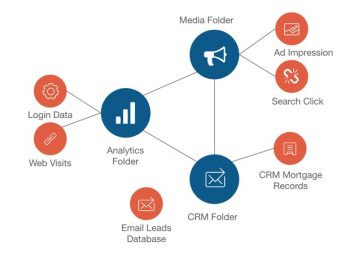
Data Management Platforms have emerged over this past decade as the leading digital segmentation technology for media deployment, audience extension and customer behaviour analysis in near real-time. Using mostly graph-based data collection and marketing AI algorithms, a DMP can collect, match and deploy 1st, 2nd and 3rd party data.
Here is a simple breakdown of each data type:
–1st Party Data: Data collected from owned media platforms by the client, such as website visits or user logins, email addresses, CRM records (hashed and encrypted for privacy compliance) or Mobile application user data.
–2nd Part Data: Data collected from partner or sponsored media platforms, such as website visits on a partner or sponsored website (i.e. National Bank of Canada could use data from visit data from the Rogers Cup website based on a sponsorship agreement) or external email lists (like Air Miles users).
–3rd Party Data: Data purchased through a DMP from Data Vendors such as Data Alliance, Exelate, BluKai, Lotame and dozens of others. These millions of data segments also serve the purpose of matching your 1st and 2nd party data with larger segments to find audiences similar to your clients.
General DMP Usage
Typically, a DMP connects your customer audience segments with DSPs (Demand-Side-Platforms) and SSPs (Supply-Side-Platforms). The latter is a bidding platform for advertisers where billions of advertising impressions of all formats (Web Banners, Video Ads, Paid Social ads) are made available in an Open Ad Exchange in real-time-bidding. The former is a platform where publishers and data providers offer their advertising inventory and audience data segments for advertisers to buy.
Using advanced machine learning algorithms, DSPs optimize advertising campaigns to bid for impressions served at the right time, in the right environment and more important, to the right audience, the very audience provided by the DMP on the backend. This entire mechanism, commonly known as programmatic ad buying, is currently becoming the standard system for both branding and performance initiatives.
DMP Types
There are many data management platform providers in the market, all of which cater to various needs and use cases within an organization. When going through the overall spectrum of DMPs on the market, we can generally categorize them into three main areas of specialization:
Data Monetization
The oldest type of DMP was typically used for the purpose of monetizing large amounts of user data on proprietary platforms. For example, a large Web Publisher like Condé Nast has hundreds of millions of pageviews / month on a vast array of digital publications. While advertising revenue from those properties remains the core revenue stream, connecting a DMP on their network allows them to create exportable audience segments from users. From there, Condé Nast can now sell these segments to advertisers who wish to reach them with ads served inside or outside of the Condé Nast network.
Content Personalization (1:1 Marketing)
Another breed of DMP specializes in content or product personalization capabilities. In essence, dynamic pixels capture various behavioural traits and content consumption trends on a given property or set of properties (website, mobile app, etc.). Based on this data, a machine learning algorithm determines which content or offers or products to serve to each user when they engage with the property. In many cases, such platforms are connected to CRM systems and marketing automation software to enable to conversation to continue via email or customer service call centres.
Advertising and Audience Extension
Lastly, the more popular and competitive type of DMP is the Advertiser-focused platform. This breed is designed to optimize advertising dollars for maximal ROAS (Return on ad spend.) As it is the case for the other breeds of this marketing technology, data is collected from various proprietary client and partner platforms (website, mobile app, etc.) and centralized into the DMP under a structured (or what should be a structured) customer trait taxonomy. Various traits can then be recombined to form larger segments, all of which can be used to for digital advertising purposes.

The advantage of this centralization process is on a number of levels. The most commonly stated advantage is probably the ability to vitiate the concomitant ad wastage caused by advertisers using several DSPs at once. For example, an advertiser is running a digital ad campaign to promote a new mobile app. So the media agency may enlist anywhere between 2 to 6 different DSPs or Ad Networks from Google, AOL, Yahoo, Rocket Fuel, etc. Typically, each DSP or network will request placing a remarketing pixel on the advertiser website. As a result, every DSP is bidding on the same high stake website visit. Naturally, what ensues is an ad frequency cap going through the roof, a very poor conversion attribution, as well as significant ad impression costs wasted on annoying the same customer 100 times through four different networks or DSPs.
Creating lookalike audiences
Another important usage is called “Lookalike Modelling”, where the DMP uses artificial intelligence or machine learning to analyze traits of your audience data to find other “non-clients” who look or behave like them, based on past digital behavior. This tactic is very useful for prospection campaigns and helps the advertiser maximize the marketing budget for performance.
The downside of DMP technology is the high cost. Not every publisher or advertiser can invest in such MarTech artillery. The alternative is to start by maximizing the digital audiences created in self-service platforms like Google Ads and Facebook Ads. As performance improves, it becomes easier to make a business case to take customer data further for the purpose of improving marketing campaigns.
As pointed it out by Andrew Lipsman, eMarketer principal analyst:
In an era of information overload, consumers appreciate brands that give them signal rather than noise,
The data management platform is a great option to reduce marketing noise around the user and focus on presenting ads, content and offers that matter to them.



